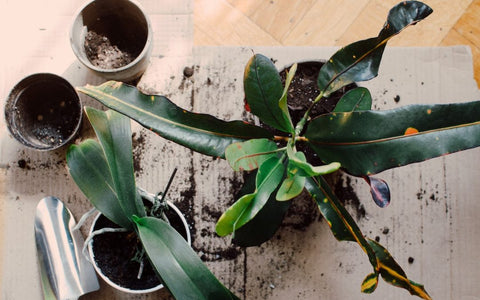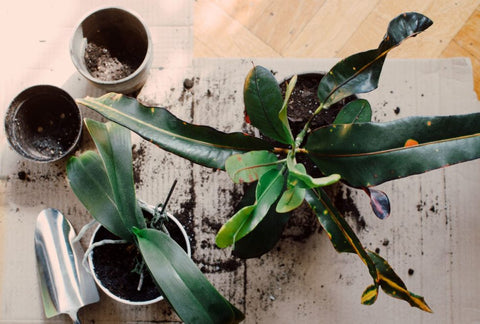An Interview With Founder Suzy Newsom about How to Pick a Pot and Potting Mix
So you bought your first (or 50th) house plant, and you want to give it the best chance for survival. The first thought that comes to your mind is soil and potting. What kind of soil do I need? Should I keep my plant in the pot it came in or do I need to re-pot it? Do I ever need to add more soil during the life of my plant? Sound familiar?
Things like finding the right soil, repotting your plants, and maintaining quality soil care all fall under the heading of “things we should do, but don’t really know how.” We’re with you. Which is why we turned to the experts for this particular topic. We talked to Suzy Newsom, the founder of Good Dirt, to answer all the questions we had about picking a pot and choosing the right soil. Read on for some key potting knowledge!

We seem to hear the term “well-draining soil” all the time, when it comes to plant care. What does that actually mean, and which plants require it?
A well-draining soil is one of the most important attributes of any potting mix or soil. It means that there is enough structure to provide porosity and aeration in the soil to allow for water and nutrients to flow through as well as roots to breathe. Roots need oxygen just as much as they need water and food. Most soils have as their main ingredient pine bark, which breaks down quickly turning the soil dense and mucky. When we crafted the recipe for Good Dirt® mixes, we created our proprietary BogBits®, a recycled byproduct from sustainably harvested peat moss that creates the structure for permanent airflow. BogBits are semi-petrified wood fibers that do not break down and have been embedded in the layers of peat for thousands of years. Because of BogBits®, gardeners can re-use our potting mix season after season. All plants, indoors or outdoors, need well-draining soil. Your garden needs to breathe.
How big should your pot be in relation to your plant?
Ideally, the pot should be 2-4” larger than the grower pot. And if propagating, the pot should be big enough for the crown of the plant, but not too large or the excess water absorbed in an oversized pot can cause root rot.

For more information on selecting the perfect pot for your edible plants, check out our blog on How to Select the Right Pot for Herbs and Vegetables.
For potting mix, does one size fit all? Or should we be getting different types of soil for different types of plants?
With Good Dirt®, one size fits all. The reason there are so many types of soil out there is to create the balance of porosity, water retention and nutrition. Good Dirt® has the porosity from the BogBits®, holds the ideal amount of moisture from our sustainable blonde peat moss and we add a complete package of plant-based nutrients as a booster as well as PlantBiotics® (beneficial microorganisms) for nutrient uptake – It’s a living soil fresh out of the bag. The Plant Food in our mixes is derived from oilseed extract, which contains everything Nature puts into a seed to reproduce the species. The natural oilseed extract contains NPK, trace elements, and all the organic compounds found in a seed. This includes all plant essential amino acids.
Talk to us about fertilizer. Is it necessary? Important? Highly essential?!
Yes, absolutely. Feeding is essential. We prefer to call it Plant Food since for a long time, the term fertilizer has been associated with chemicals. As our plants get watered, overtime, the nutrients are leached out of the soil and need replenishment. Roots need as much food to grow and thrive as any other living being. The important part is to avoid salt-based fertilizers because they accumulate salt in the soil and eventually can burn roots and leaves.

What do you look for in a pot beyond “it just goes with my aesthetic”?
We can’t say this enough – drainage holes! The number one reason plants shrivel and die is overwatering. A well-draining soil is important, but so are the drainage holes in the pot to allow excess water to flow out. Plants don’t like wet feet or their roots will rot. Another myth is adding rocks or pebbles to the bottom of a pot. That is not drainage. We are against adding rocks. Science has proven that rocks impede drainage instead of improve it. Bottom rocks actually reduce drainage capacity from the drainage hole and create a damming effect, keeping the moistest soil close to the roots, which again, can cause root rot. If using a saucer, empty out any excess water in the saucer after watering or roots will soak it back up and rot.

Is it bad to keep the plant in the plastic pot you buy it in? How important is it to transport a plant to an entirely new pot? And if important, can you explain to us the best practices for doing so?
You can keep the plant in the plastic grower pot, but we recommend repotting (in the grower pot or another pot) within two weeks of getting the plant. Growers mostly use short term soil for their crops to make input such as soil more economical. The soil used in greenhouses and nurseries is good for short term plant needs and under controlled conditions. Once we move our plants to our homes, they should be repotted in nutritious, well-draining soil. Sometimes, if it is a larger plant, you can repot with fresh soil in the plastic container, re-use the pot and place it inside a decorative pot. The plastic pot is often lighter than ceramic or terracotta pots and makes it easier to give the plant a good watering in the sink or shower, plus it is less plastic in the landfill.









